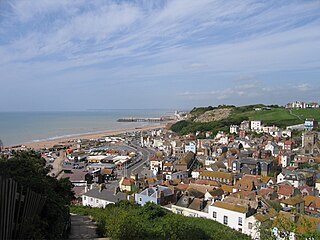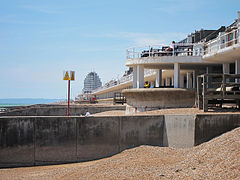
Hastings is a seaside town and borough in East Sussex on the south coast of England, 24 mi (39 km) east of Lewes and 53 mi (85 km) south east of London. The town gives its name to the Battle of Hastings, which took place 8 mi (13 km) to the north-west at Senlac Hill in 1066. It later became one of the medieval Cinque Ports. In the 19th century, it was a popular seaside resort, as the railway allowed tourists and visitors to reach the town. Today, Hastings is a fishing port with the UK's largest beach-based fishing fleet. It has an estimated population of 91,100 as of 2021.

Mulberry harbours were two temporary portable harbours developed by the British Admiralty and War Office during the Second World War to facilitate the rapid offloading of cargo onto beaches during the Allied invasion of Normandy in June 1944. Designed in 1942 and then built in under a year in great secrecy, within hours of the Allies successfully creating beachheads following D-Day, sections of the two prefabricated harbours and old ships, to be sunk to create breakwaters, were being towed across the English Channel from southern England and placed in position off Omaha Beach and Gold Beach.
Sir William Halcrow was one of the most notable English civil engineers of the 20th century, particularly renowned for his expertise in the design of tunnels and for projects during the Second World War.

A breakwater is a permanent structure constructed at a coastal area to protect against tides, currents, waves, and storm surges. Breakwaters have been built since Antiquity to protect anchorages, helping isolate vessels from marine hazards such as wind-driven waves. A breakwater, also known in some contexts as a jetty or a Mole, may be connected to land or freestanding, and may contain a walkway or road for vehicle access.

In geotechnical engineering, a caisson is a watertight retaining structure used, for example, to work on the foundations of a bridge pier, for the construction of a concrete dam, or for the repair of ships.

Sir Ove Nyquist Arup, CBE, MICE, MIStructE, FCIOB was an English engineer who founded Arup Group Limited, a multinational corporation that offers engineering, design, planning, project management, and consulting services for building systems. Ove Arup is considered to be among the foremost architectural structural engineers of his time.

MOSE is a project intended to protect the city of Venice, Italy, and the Venetian Lagoon from flooding.

Newton's Cove is a small cove, 0.5 kilometres (0.3 mi) south of Weymouth, Dorset, England. Overlooking Portland Harbour, the cove is close to Nothe Gardens and the Nothe Fort.

Battery Rocks are a rocky headland to the south of the harbour of Penzance, Cornwall, UK.
Holloway Brothers (London) Ltd was a leading English construction company specialising in building and heavy civil engineering work based in London.

The Labworth Restaurant & Café is a modernist International style reinforced concrete building overlooking the Thames estuary at Labworth beach on Canvey Island, Essex. Built in 1932–1933 by Ove Arup to resemble the bridge of the Queen Mary, it exists as the only building solely designed by the distinguished engineer.

John Holmes Jellett Officer of the Order of the British Empire (OBE), DSc, MA was a British civil engineer. Jellett started his career as a bridge and canal engineer before joining the Admiralty, where he specialised in docks. He made improvements to the Royal Navy dockyards and depots at Chatham, Singapore, Devonport, Gibraltar and Milford Haven in the 1930s. During the Second World War Jellett was responsible for works in Egypt and Malta as superintendent civil engineer for the Eastern Mediterranean. After service in the Mediterranean, he was superintending engineer for Mulberry Harbour B that supplied the allied forces in France after the Normandy Landings. Jellett was appointed an OBE for this work in late 1944. After the war he worked for the Southern Railway and then the British Transport Commission in Southampton Docks. Jellett served as president of the Institution of Civil Engineers in 1968–69.

Allan Harry Beckett MBE was an English civil engineer whose design for the 'Whale' floating roadway was crucial to the success of the Mulberry harbour that was used in the Normandy Landings. Starting the war as a sapper digging trenches on the South Coast at the time of the Dunkirk evacuation, Allan Beckett came to play a significant role in the success of the Mulberry harbour used during and after the Normandy landings of June 1944.

Malamocco was the first, and for a long time, the only, settlement on the Lido of Venice barrier island of the Lagoon of Venice. It is located just south of the island's center and it is part of the Lido-Pellestrina borough of the municipality of Venice.
Sir Lindsay Parkinson & Company Ltd, commonly known as Sir Lindsay Parkinson & Co. Ltd or Lindsay Parkinson, was a civil engineering company in the UK. It was responsible for the construction of a significant part of the UK motorway network, including elements off the M4 and the M6. It was acquired by Leonard Fairclough & Son in 1974.

Quaianalagen or Seeuferanlagen on Lake Zürich is a series of lakefronts in Zürich. Inaugurated in 1887, the quaysides are considered an important milestone in the development of Zürich. The construction of the lake fronts transformed the medieval small town on the rivers Limmat and Sihl to a modern city on the Lake Zürich shore. The project was managed by engineer Arnold Bürkli.

Wollongong Harbour Precinct is a heritage-listed shipping harbour at Cliff Road and Endeavour Drive, in Wollongong, New South Wales, Australia. It was built in 1837. The historic precinct includes Belmore Basin, Government Dam, Government Basin, Stockade Point, Flagstaff Hill, Signal Hill, Brighton Beach, Boat Harbour and Fortress Hill. It was added to the New South Wales State Heritage Register on 5 May 2010.
Sir Alan James Harris CBE was a British civil and structural engineer.

St Leonards Pier, also known as the Palace Pier, was a public pleasure pier in St Leonards-on-Sea, part of the town and borough of Hastings in East Sussex, England. Opened in 1891 the pier was a direct rival to nearby Hastings Pier, and during its heyday the pier was a leading tourist attraction, and was described in the 1894 Baedeker travel guide as handsome. The pier was damaged during WW2 and left derelict after the war until purchased by Hastings Corporation in 1951 who demolished the structure over the next two years.

Marine Court is a Grade II listed Streamline Moderne apartment block on the seafront of St Leonards-on-Sea, part of the town and borough of Hastings in East Sussex, England. The block was built between 1936 and 1938 and was modelled on the recently launched Cunard ocean liner Queen Mary. The building is 14 stories high and the seafront elevation 416 ft (127 m) long. At the time of opening it was the tallest residential building in Britain.

















